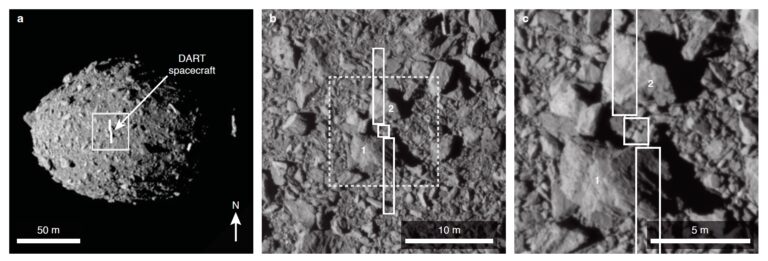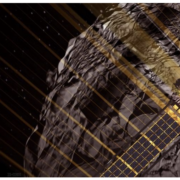International teams, with the participation of the Centro de Astrobiología (CAB), CSIC-INTA, publish today in Nature the results of the first observations of NASA’s DART mission.
Understanding how the impact of the DART spacecraft modified the orbit of the asteroid Dimorphos will help in the development of strategies and defense systems against possible collisions of astronomical objects with the Earth.
The DART mission ran a spacecraft into Dimorphos, the moon of near-Earth asteroid (65803) Didymos, on 27 September 2022 (CET). The aim of the collision was to change the orbit of the moon, testing a potential method of asteroid deflection. Scientists from CAB, CSIC-INTA, have participated in reconstructing the impact of the DART spacecraft on Dimorphos and in analyzing the Hubble Space Telescope observations of the ejected material by the DART impact. These interesting results are reported in two scientific articles published in Nature today.
Several experiments, carried out in the EPIC chamber (Experimental Projectile Impact Chamber) of the Centro de Astrobiología (CAB), CSIC-INTA, have served to validate the numerical codes used in simulations to predict and interpret the effects of NASA’s DART kinetic impactor onto the asteroid Dimorphos.
Successful Kinetic Impact into an Asteroid for Planetary Defence
In a pioneering study led by Ronald Terik Daly (Johns Hopkins University Applied Physics Laboratory, USA), the scientists from CAB, Jens Ormö and Isabel Herreros, along with other DART Investigation Team members, reconstruct the impact of the DART spacecraft on Dimorphos, which may help with the planning of future missions and could help to predict outcomes with more certainty. They also describe the location and nature of the impact site, noting that it was between two boulders, one of which was grazed by the spacecraft as it made contact with the moon.

Ejecta from the DART-produced active asteroid Dimorphos
The researchers from CAB, Jens Ormö and Isabel Herreros, take part in the study led by Jian-Yang Li (Planetary Science Institute, Tucson, USA), analyzing the Hubble Space Telescope observations of the ejecta plume (debris) created by the DART impact. The speed and evolution of this ejected material may explain the momentum change caused by the impact.
Some active asteroids have been proposed to be the result of impact events. Because active asteroids are generally discovered serendipitously only after their tail formation, the process of the impact ejecta evolving into a tail has never been directly observed. NASA’s Double Asteroid Redirection Test (DART) mission, apart from having successfully changed the orbital period of Dimorphos, demonstrated the activation process of an asteroid from an impact under precisely known impact conditions. Here the observations of the DART impact ejecta with the Hubble Space Telescope (HST) from impact time T+15 minutes to T+18.5 days at spatial resolutions of ~2.1 km per pixel are reported. The observations reveal a complex evolution of ejecta, which is first dominated by the gravitational interaction between the Didymos binary system and the ejected dust and later by solar radiation pressure. The lowest-speed ejecta dispersed via a sustained tail that displayed a consistent morphology with previously observed asteroid tails thought to be produced by impact. The ejecta evolution following DART’s controlled impact experiment thus provides a framework for understanding the fundamental mechanisms acting on asteroids disrupted by natural impact.

The research team at CAB conducted several experiments with impact velocities of about 400 meters per second with different target configurations to understand how boulders in the target material (i.e., “rubble-pile”) affect the material ejection, the shape of the crater and lowers momentum transfer (i.e. the effective “push” of the asteroid).
These results assisted in the validation of the numerical models used by the DART Investigation Team to predict and interpretate the outcomes of the mission.

More information
Neither Dimorphos nor Didymos poses any hazard to Earth before or after DART’s controlled collision with Dimorphos. Johns Hopkins Applied Physics Lab built and operated the DART spacecraft and manages the DART mission for NASA’s Planetary Defense Coordination Office as a project of the agency’s Planetary Missions Program Office. LICIACube is a project of the Italian Space Agency (ASI), carried out by Argotec.
For more information about the DART mission, visit https://www.nasa.gov/dart o https://dart.jhuapl.edu
Access to the publications in Nature (01/03/23)
Daly et al.: https://www.nature.com/articles/s41586-023-05810-5 (DOI: 10.1038/s41586-023-05810-5)
Li et al.: https://www.nature.com/articles/s41586-023-05811-4 (DOI: 10.1038/s41586-023-05811-4)








![Imagen2 Photo from one of the EPIC (CAB CSIC-INTA) “rubble-pile” impact experiments obtained with a high-velocity video camera. It shows how embedded “boulders” in the target move in relation to the sand matrix. The crater is approximately 20cm wide- Credits: Laboratory for Experimental Impacts (CAB, CSIC-INTA) [Image modified from Ormö et al., 2022].](https://cab.inta-csic.es/wp-content/uploads/elementor/thumbs/Imagen2-punoytwyi1lgt1pm7426kj98mxv8xq1528bxx7eeiw.jpeg)
